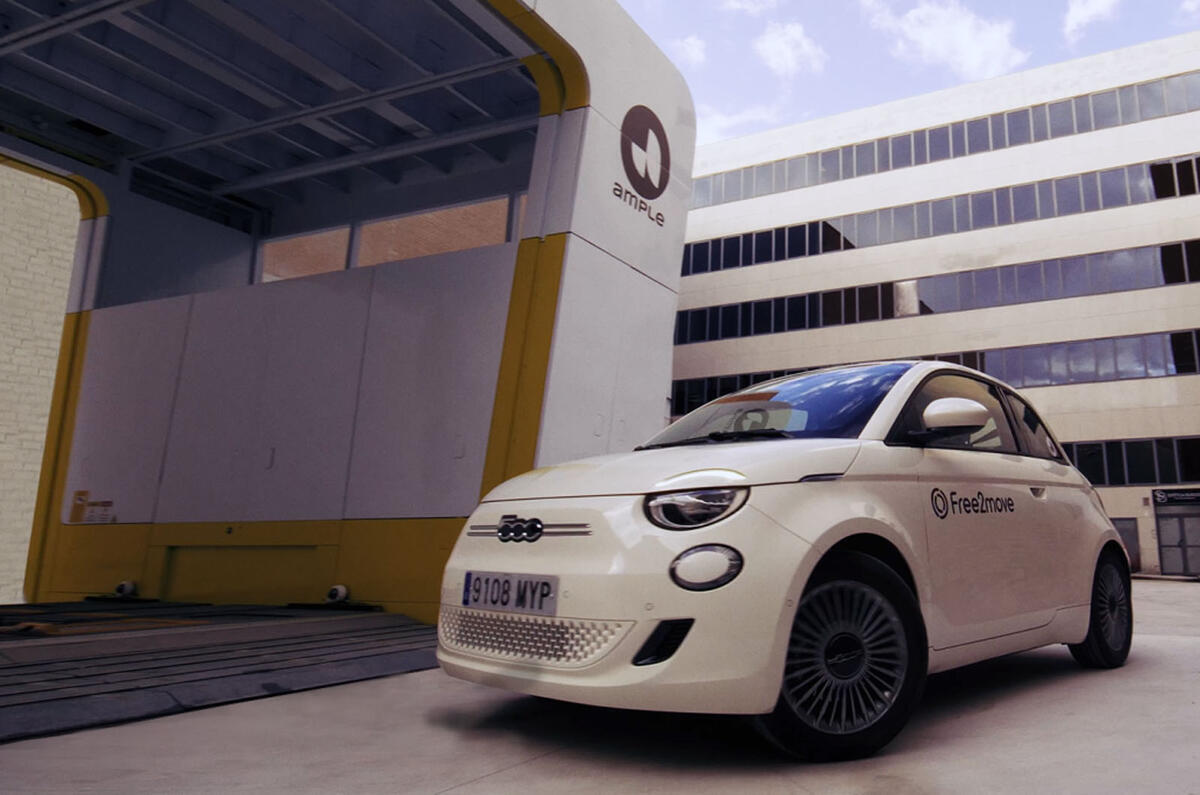Pull into a petrol station with an electric Fiat 500e in Madrid, Spain, and you could soon be filling up almost as quickly as you would in the old combustion-engine version.
This magic is down to a conversion of the EV carried out for the FreetoMove car share business of Stellantis, Fiat's owner. The conversion itself is the work of start-up Ample, which has reinvented the idea of battery swapping to make it more accessible, and it is now being launched in Spain.
The reason it will probably happen in a petrol station is because two of Ample’s early investors were Shell and Spanish oil company Repsol, both of which were casting about for fresh uses for hundreds of fuel station sites in the EV age.
Many have touted the idea of battery swapping, including Tesla during its early days. So far, however, only Chinese electric car company Nio has made a decent go it, with 3408 so-called Power Swap stations globally relieving the need of owners to charge their cars.
But Nio’s solution has a key drawback that Ample reckons it has overcome. “One of the key historical challenges is what they call pack-level swapping, where you swap the whole battery pack,” Juan Spiniak, head of product at Ample, told Autocar at the recent Move event in London. “That requires standardising the battery pack across all vehicles. And that's really, really hard.”
Ample’s solution is to retrofit existing EVs so they can accept its modular battery packs. The company reckons it can engineer an adaptation for an existing car in around three months and the intention is that eventually the changes can be implemented on the production line, rather than aftermarket.
Vehicles adapted so far include the Nissan Leaf and Kia eNiro in the company’s home city of San Francisco, the US, in a partnership with Uber, as well as a Mitsubishi eCanter truck and dinky Minicab-MiEV delivery van on trial in Tokyo.
So far, Stellantis has handed over 21 Fiat 500e EVs for Ample to convert in Madrid and that will rise to 100 “very soon”, Anne Laliron, head of tech research at Stellantis, said at the Move event.
“What is amazing is that we don't have to change so much in the car because it's easy to integrate. We don't need to touch the platform,” said Laliron.
The other innovation is that Ample can install whichever battery chemistry it likes into its pack modules and the car is programmed to adapt, meaning the company can offer a cheaper solution such as sodium batteries when they become viable. Splitting the modules into three, meanwhile, allows users can decide how many they need for the journey they plan.
By choosing to focus on taxi drivers, car share users and delivery drivers, Ample has targeted urban EV use cases that require fast top-ups. That’s because downtime costs money, particularly in the case of FreeToMove car share customers in Madrid, who are charged 19 cents every minute. A swap takes on average five minutes, the company reckons.
Focusing on corporate customers also avoids the issue of adding battery leasing on top of the purchasing price – something that is possibly a factor in Nio’s slower than expected take-up in Europe.
Ample is rolling out 10 stations in Madrid but reckons it needs only three to six in an average city to have the coverage it requires.
Battery swapping is making a bit of comeback in Europe after the dramatic collapse of the much-touted Better Place in 2013, which trialled swapping with Renault Fluence cars in Israel.
Urban-focused quadricycles are investigating the tech – for example, the S04 from Nissan-backed Spanish maker Silence. That car’s 5.6kWh batteries sit underneath the seats and can be removed and charged indoors thanks to in-built wheels and trolley handle.
Alternatively, users can sign up to a monthly subscription and replace them at specific stations, following a business strategy successfully pioneered by scooter companies led by Taiwan’s Gogoro, which has since signed up other two-wheeler firms, including Yamaha, to accept its batteries.
Meanwhile, Chinese company U Power announced earlier this month that it is bringing its UOTTA battery swap solution to Portugal for use in taxis. The company said the first phase would provide two swapping stations and 120 battery-swapping taxis. The company didn’t name the cars, but its launch into Thailand with similar battery swap technology earlier this year will use electric models from MG.
The company said its business model is to “integrate vehicles, swapping stations and spare batteries into one platform”, meaning drivers would pay a single fee for vehicle lease, battery and charging.
However, the biggest advocate of battery swapping for private car users remains Nio and it has a chance to win over mass-market buyers to the technology with the launch of the budget Firefly small hatchback in European markets later this year. Whether Nio will support growth of battery-swapping sites just for this one model remains to be seen, but the company is likely to remain at forefront of a technology it has championed from the start.




Add your comment